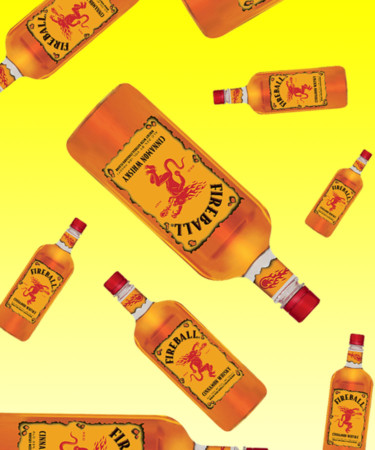It’s likely that just the cinnamony aroma of Fireball elicits memories of your younger years and reckless adventures. Fireball’s telltale smell is instantly recognizable; just one whiff can remind imbibers of that burning feeling. No one says it better than Fireball itself: “Takes like Heaven, burns like Hell.”
But given the meteoric rise of Fireball Cinnamon Whisky, which grew like a wildfire from $1.9 million in sales in 2011 to $863.5 million in 2014, Fireball warrants a little more respect than just the passing nostalgic nod to your past. Even now, the Canadian whisky remains on fire, with 5.65 million 9-liter cases sold in 2019.
Here are 11 things you should know about Fireball.
-
It’s not technically “whiskey.”
Whiskey is defined as a spirit that’s at least 40 percent alcohol by volume. Clocking in at a lower 33 percent ABV, Fireball is more of a flavored whiskey, or, to get technical, a “specialty” distilled spirit. This is also why Fireball shots are just so easy to knock back. Some mornings, we might even say too easy.
-
You can thank Canada for Fireball.
Insofar as Fireball mythology exists, at least one origin story points to a Canadian bartender trying to warm up on one of those typical frigid Canadian nights. Apparently, booze alone wouldn’t suffice, so this mystery bartender added cinnamon and sugar. Regardless of whether or not this story is true, we still owe those Canadians some kudos, since Fireball is made with Canadian whisky.
-
Fire and…ice?
Fireball was recalled due to concerns it contained an ingredient used in antifreeze. This ingredient is propylene glycol, otherwise known as part of the mixture used to de-ice airplanes. In 2014, Fireball was recalled in European countries because propylene glycol levels were deemed too high. But don’t worry, both the FDA and CDC have deemed propylene glycol safe at low levels of consumption.. Fireball replaced its European bottles immediately and has not recalled any products in the U.S. Plus, you’ve probably been consuming propylene glycol for a while now; it’s used in everything from cosmetics to ice cream.
-
People cook with it. On purpose.
Some home cooks incorporate Fireball into a wide, weird variety of recipes ranging from marshmallows to meatballs. Of course, there are the trillion different Fireball shots recipes, but the food is where it gets really interesting.
-
Fireball was a late bloomer.
Fireball’s been around since 1984, but America only fell in love with it in the late 2000s. Part of the delay in popularity might have to do with the fact that it was only available in Canada until 2001 with the less-than-sexy name “Dr. McGillicudy’s Fireball Whisky.” But Sazerac bought it, gave it a makeover, and — most impressively — took to the streets to market the stuff face-to-face grassroots style. Soon enough, America fell head over heels.
-
There was a brief, ill-fated attempt at boxing Fireball.
Take all the classiness of Fireball and add all the classiness of box wine, and you have the failed 2016 experiment known as the “Firebox.” While Franzia and Fireball might occupy a similar space in your brain, perhaps it’s best they don’t get married.
-
There’s a Fireball app.
There’s an app for the official Fireball drinking game, “Dragons, Dice & Dares.” Unfortunately there are very few dragon-related challenges in the game. Instead, players encounter things like forced confessions of embarrassing personal history and toilet paper-related dares.
-
Country musicians love it.
Country music’s a pretty polarizing genre, and Fireball’s the same: you either hate it or love it (but hopefully if you’re here, you love it.) Though Fireball’s behind virtually every bar in the United States, some people have a vendetta against it. Luckily, country band Florida Georgia Line is on Fireball’s side — in their song Round Here, they give it a shoutout. Blake Shelton’s a fan, too.
-
Fireball’s inspired a bunch of imposters.
While the brand might have haters galore, it also inspired a bunch of copycats. Not only did Fireball sue the small brand Stout Brewing Company for creating an almost laughable carbon copy of their liquor (down to the devil-centric packaging), they also sued whiskey giant Jack Daniels in the same year. Jack Daniels and Jim Beam both created cinnamon-flavored whiskeys after seeing Fireball’s success, but Fireball’s beef with Jack came from its use of the word “fireball” in its Google advertisements. Looks like 2015 was a busy year for Fireball in court.
-
It’s setting world records.
The current world record for most Fireball shots taken at once was set on St. Patrick’s Day in 2012 in Nashville. That day, 4,750 shots were taken at once. As it turns out, Nashville is deemed the Fireball mecca for good reason.
-
It’s Pappy’s cousin.
Yes, Fireball is related to Pappy Van Winkle, the legendary, uber-expensive unicorn whiskey that goes for thousands of dollars a bottle. Sazerac, the company that owns Fireball, also owns Buffalo Trace Distillery. So next time you think Fireball belongs on the bottom shelf, look at its kin.
FAQs
Can you drink Fireball straight?
Yes, you can drink Fireball straight. While it’s sometimes used as an ingredient in cocktails, Fireball is often consumed as a shot.
What type of alcohol is Fireball?
Commonly mistaken for whiskey, Fireball is actually a “specialty” distilled spirit. For a spirit to be officially deemed whiskey, it must be at least 40 percent alcohol by volume — Fireball falls just short, clocking in at a lower 33 percent ABV.
What mixes good with Fireball?
The cinnamon-forward spirit pairs well with citrus fruits, such as lemon and orange, as well as apple. VinePair compiled 12 Fireball-based cocktails that riff on classic drinks such as Sangria and cider.
